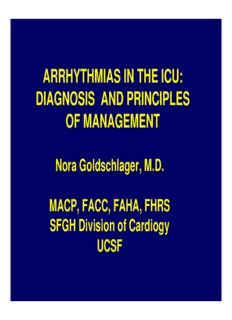
arrhythmias in the icu PDF
Preview arrhythmias in the icu
ARRHYTHMIAS IN THE ICU: DIAGNOSIS AND PRINCIPLES OF MANAGEMENT Nora Goldschlager, M.D. MACP, FACC, FAHA, FHRS SFGH Division of Cardiogy UCSF CLINICAL VARIABLES IN ARRHYTHMOGENESIS • Ischemia/infarction (scar) • Electrolyte imbalance • Proarrhythmia • Autonomic nervous system QT interval Heart rate variability Baroreflex sensitivity VENTRICULAR TACHYCARDIA • Sustained (> 30 sec duration or immediately hemodynamically destabilizing) • Nonsustained (< 30 sec duration) • Monomorphic (same QRS configuration in given lead) • Polymorphic (multiple QRS morphologies in given lead) – Without long QT (generally ischemic) – With long QT (Torsades de pointes) HEMODYNAMICALLY DESTABILIZING VT: CLINCAL CORRELATES • Age • Ejection fraction • Rate • Duration • VA conduction • Depressed baroreflex sensitivity ACCELERATED VENTRICULAR RHYTHM • Rates between ‘idioventricular’ escape rate and VT (110/min) • Classically has onset with slowing of sinus rate and offset with increase in sinus rate; isorhythmic AV dissociation common • Classically has onset and offset with fusion complexes • Thought to be automatic • Usually lasts seconds; may last minutes to hours (rare) • May indicate reperfusion injury in acute MI patients • Not a rhythm of digitalis toxicity • Benign MECHANISMS OF ARRHYTHMOGENESIS • Abnormal automaticity • Reentry • Triggering (afterdepolarizations) SOME ECG FEATURES OF VT MECHANISMS Automatic: Warmup Warmdown Uniform morphology Reentry: Monomorphic Afterdepolarizations: Polymorphic Usually nonsustained Pause dependency QTU prolongation U wave accentuation
Description: